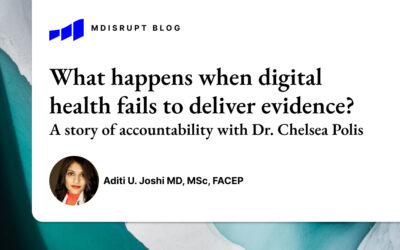
Meet Jennifer Swoyer, DO, who leads the family medicine residency program at AMITA Health Adventist Medical Center in La Grange, Illinois.

Dr. Swoyer is a family physician who has been in practice for over 20 years. Her passion lies in teaching and clinical medicine, helping underserved populations, and improving access to health and wellness programs.
Health consumers driving change
MDisrupt: How is the traditional family practice evolving to meet the demands of health consumers?
Jennifer Swoyer: Family medicine is evolving quickly, as are most aspects of medicine. For primary care providers, the pandemic shed new light on how we need to integrate technology to improve the quality of care for our patients.
For example, telehealth has been around for a while, but with the pandemic, there were changes that allowed us to be able to integrate it better. The beauty of telehealth is that we were able to screen patients differently, do follow up visits more easily, and stop limiting patients to the schedules that we set. We were able to be much more flexible in making sure that patients got the care that they need and deserve—and this is here to stay.
Technology to engage patients and improve health
MDisrupt: It’s been estimated that there are somewhere between 200K to 400K avoidable, preventable deaths each year in the US. How can physicians partner with health innovators to improve those stats?
Jennifer Swoyer: For medical professionals, preventing deaths is always our goal. Technology, depending on how it’s utilized, can really become a team approach between the provider and patient. The best thing about point-of-care technology is that the individual who has the disease or condition being monitored now has a daily opportunity to understand their own health. That allows me to do a better job as a provider and it becomes more of an opportunity for us to prevent bad outcomes. There are many examples of where we can use these technologies to help this partnership work better.
When we talk about population health and social determinants of health, we’ve seen the healthcare landscape change over the last few years. Healthcare systems have consolidated services to try and create one-stop shopping experiences: If you need to go see your provider, you can also get your X-ray and your labs, everything done in one location. This is really great and improves convenience. When health systems moved to single locations, however, they removed a lot of the providers that were in the community and consolidated them, reducing some of the access. Having mobile clinics that go out to shelters or large church organizations is an amazing outreach opportunity where you can reach a large population and then connect them with technology.
A call to action
MDisrupt: Many in the MDisrupt audience are entrepreneurs who have access to capital, technology, and engineers to build solutions. How can we help?
Jennifer Swoyer: Digital innovators are focusing on important problems that we need to solve, but to truly solve problems requires the right input. Providers in an urban setting, for example, may bring up a very different set of needs than providers in a rural setting. Engaging entrepreneurs and digital thinkers to incorporate views from many types of providers will help align how technology is utilized and ultimately change the trajectory of patient care.
What physicians need from digital health
MDisrupt: As a provider, what do you see as the most important components of a digital health product?
Jennifer Swoyer: I look at digital health products through two different lenses: patient-forward technology and physician-centered technology. In terms of patient-forward, I look for technology that is usable by the patient and builds ownership and accountability, which will then help me, as the provider, help them manage their health differently. If the technology is physician-centered then it really needs to be technology that is going to help physicians do their jobs better by improving patient outcomes, more easily meeting quality measures, and saving time. Ideal solutions will improve patient satisfaction and physician well-being.
Meeting patients where they are
MDisrupt: Is there something you’ve changed your opinion on since you started practicing medicine?
Jennifer Swoyer: There can be numerous factors that contribute to individuals being successful in managing their genetic predisposition and lifestyle-created conditions. I’ve realized that my job is to work with someone where they are to get the best results and not necessarily focus on all the things that they need to do. For example, when we talk about obesity or diabetes, we focus on the type of diet and exercise you need. Those are things I will continue to talk about, but you have to look at where someone is in their life and what they are facing on a daily basis. If your meal supply is supplemented by a food pantry, you no longer have the same control over the foods you eat. We need to make sure the solutions we are providing and the advice that we are giving work with the individual’s social needs. This is the piece where I have changed the most. I ask questions very differently. I try to work with people where they are and help them get to where they should be.
Bringing healthcare home
MDisrupt: How will traditional health systems do things differently to adapt to a new model of healthcare?
Jennifer Swoyer: We’re all connected all the time now. Continuing to utilize the tools that almost everyone has—a cell phone, an iPad, a laptop—is part of where we need to start. The healthcare landscape is going to continue to change, and it should. Hospitals will be for the sickest patients and people who are less sick will—I hope—no longer be hospitalized and instead will be home-monitored remotely through digital tools.
Providers who are not in an acute setting like the emergency room, but who are part of a primary care practice, will be linked into how the followup gets done and will have access to daily technology for that individual.
As a family medicine physician, I still see patients in the hospital. Patients will ask me,”How long am I going to continue to feel tired?” I always give my math, which is not scientific but is founded on my experience: Every day you spend in the hospital is a week of recovery. We could do better by recuperating at home in our own beds if we could be monitored.
Advice for innovators
MDisrupt: What advice would you give a founder who wants to create tools for better health and wellness?
Jennifer Swoyer: Most physicians go into medicine because we love what we do. It’s an art and a passion. I want to help people be well. I’m most willing to adopt technologies that help me improve my patients’ health, and reduce burnout. It’s critical to look at who is the adopter of the technology and whether it will help me provide better care. Can that adoption of technology ensure that my billing and collections are better? You don’t want technology to be an additional burden on an already-busy life and schedule.
At MDisrupt we believe that the most impactful health products should make it to market quickly. We help make this happen by connecting digital health innovators to the healthcare industry experts and scientists they need to responsibly accelerate product development, commercialization, adoption, and scale.
Our expert consultants span the healthcare continuum and can assist with all stages of health product development: This includes regulatory, clinical studies and evidence generation, payor strategies, commercialization, and channel strategies. If you are building a health product, talk to us.



